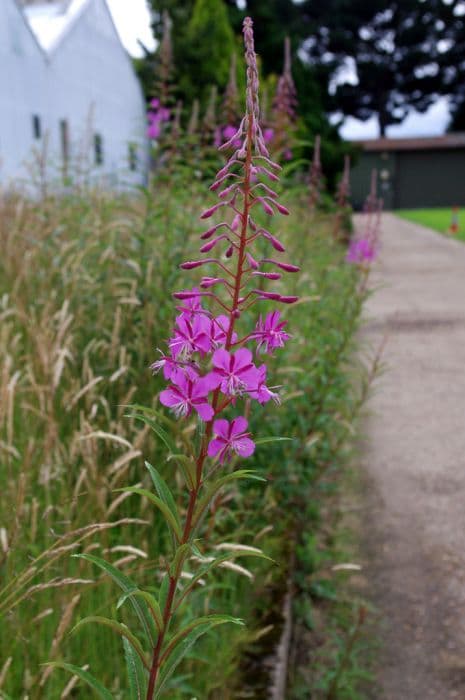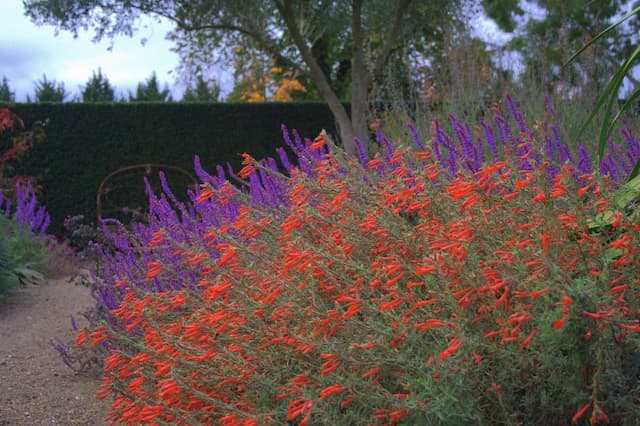Dodonaei Willowherb Chamaenerion dodonaei

ABOUT
Chamaenerion dodonaei, commonly known as Dodonaea's willowherb, is a perennial plant that belongs to the evening primrose family. This plant is recognized for its erect and straight growth habit, often bearing leaves arranged alternately along its stem. The lance-shaped leaves are notable, with a somewhat elongated form tapering to a point. Its foliage typically offers a rich green hue, occasionally with a slight bluish or grayish cast, depending on the environmental conditions. In bloom, Dodonaea's willowherb produces a striking display of flowers, which are arranged in a spike-like fashion at the top of the stems. Each individual flower is modest in size and features four petals that can vary from deep pink to pale pink or even white. The petals radiate around a set of central stamens and a prominent ovary, which is characteristic of the evening primrose family. After flowering, the plant forms seed capsules that elongate and open at maturity, releasing numerous small seeds that are dispersed by the wind. These capsules add another layer of visual interest to the plant and can persist on the stem after the petals have fallen. Dodonaea's willowherb possesses a certain hardiness and adaptability, often found in a variety of landscapes, including open meadows, roadside verges, and disturbed grounds, where it contributes to the local flora with its delicate blooms and characteristic form.
About this plant
 Names
NamesFamily
Onagraceae
Synonyms
Dodonaeus' Willowherb
Common names
Chamaenerion angustifolium subsp. dodonaei, Epilobium dodonaei.
 Toxicity
ToxicityTo humans
Chamaenerion dodonaei, commonly known as Dwarf Fireweed, is not widely recognized for significant toxicity to humans. However, as with any plant, individual sensitivities can vary, and some people might experience mild gastrointestinal upset or an allergic reaction if they ingest parts of the plant or come into contact with its sap. It is always advisable to use caution and avoid ingesting parts of plants that are not commonly recognized as food to prevent the potential for adverse effects.
To pets
Dwarf Fireweed (Chamaenerion dodonaei) is not commonly known to be toxic to pets. Nevertheless, individual animals can have different levels of sensitivity, and ingestion of the plant may lead to gastrointestinal discomfort or an allergic reaction in some pets. It's always best to keep an eye on your pets and to prevent them from consuming non-food plants, since even non-toxic plants can cause gastrointestinal upset or other issues in pets due to their different digestive systems.
 Characteristics
CharacteristicsLife cycle
Perennials
Foliage type
Deciduous
Color of leaves
Green
Flower color
Pink
Height
3-4 feet (0.9-1.2 meters)
Spread
1-2 feet (0.3-0.6 meters)
Plant type
Herb
Hardiness zones
5
Native area
Eurasia
Benefits
 General Benefits
General Benefits- Ornamental Value: Adds visual appeal to gardens and landscapes with its colorful flowers.
- Attracts Wildlife: Provides nectar for bees, butterflies, and other pollinators, enhancing local biodiversity.
- Erosion Control: Can be used on slopes and banks to prevent soil erosion due to its root system.
- Drought Tolerance: Once established, it requires minimal water, making it suitable for xeriscaping in dry regions.
- Low Maintenance: Generally requires minimal care, making it a good choice for novice gardeners or those with limited time.
- Cold Resistance: Tolerates cold climates well, which is beneficial for gardens in regions with harsh winters.
- Adaptability: Can thrive in a variety of soil types, from sandy to loamy, as long as there is good drainage.
- Fast Growth: Enables quick coverage of areas, useful for new plantings and restoration projects.
- Ecological Role: Plays a part in native ecosystems and can help in conservation efforts for preserving natural flora.
 Medical Properties
Medical PropertiesThis plant is not used for medical purposes.
 Air-purifying Qualities
Air-purifying QualitiesThis plant is not specifically known for air purifying qualities.
 Other Uses
Other Uses- Fireweed honey production: Chamaenerion dodonaei flowers are a source of nectar for bees, who produce a distinctive type of honey known as fireweed honey.
- Natural dye: The plant can be used to create a range of natural dyes for fabrics, with shades varying from yellow to green depending on the mordant used.
- Erosion control: Fireweed can grow quickly in disturbed sites, helping to stabilize soil and prevent erosion in such areas.
- Craft material: The fluffy seeds and fibrous stems have been used in the past for stuffing pillows and for creating paper-like crafts.
- Indicator species: Fireweed is an early colonizer of burned areas, thus its presence can indicate a recent fire in the ecosystem.
- Culinary garnish: The vibrant flowers can be used to decorate salads and deserts, adding a splash of color to the presentation of a dish.
- Natural cordage: The strong, fibrous stems of the plant can be twisted or braided to create natural cordage for various uses.
- Environmental education: Fireweed serves as an excellent example in teaching about plant succession and habitat recovery processes.
- Photography subject: Due to its striking appearance, fireweed is often used as a subject in nature photography and visual arts.
- Wildlife support: The plant provides habitat and food for a variety of insects, including butterflies and moths, thus supporting biodiversity.
Interesting Facts
 Feng Shui
Feng ShuiThe Chamaenerion dodonaei is not used in Feng Shui practice.
 Zodiac Sign Compitability
Zodiac Sign CompitabilityThe Chamaenerion dodonaei is not used in astrology practice.
 Plant Symbolism
Plant Symbolism- Resilience: Chamaenerion dodonaei, commonly known as Dwarf Fireweed, often grows in challenging environments, symbolizing the ability to endure and thrive in difficult conditions.
- Healing: Since many species in the genus Chamaenerion have been used in traditional medicine, Dwarf Fireweed might be associated with healing and the restoration of health.
- Adaptation: Dwarf Fireweed has the capability to adapt to its surroundings, symbolizing flexibility and the capacity to adjust to changing situations.
- Beauty: As with its relative, the Fireweed, this plant with its colorful blooms could symbolize the beauty that emerges despite adversity.
- Regrowth: This plant is known to colonize areas after disturbances such as wildfires, thus it could represent new beginnings and the promise of regeneration after destruction.
 Water
WaterThe fireweed (Chamaenerion dodonaei) prefers consistent moisture but is relatively drought-tolerant once established. During the growing season, water the plant deeply once a week, providing about 1 to 1.5 gallons of water per plant, depending on soil conditions and climate. If the weather is exceptionally hot or dry, increase watering frequency to twice a week. Always check the top inch of soil for dryness before watering again to prevent overwatering. During the winter or in cooler climates, reduce watering, ensuring the plant gets water every other week if there's no significant rainfall.
 Light
LightFireweed thrives in full sunlight to partial shade. The ideal spot for this plant would be a location where it can receive at least six hours of direct sunlight each day. If grown indoors, it should be placed near a south-facing window to ensure it gets enough light. While it can tolerate some shade, too little light may inhibit optimal growth and flowering.
 Temperature
TemperatureFireweed is hardy and can tolerate a range of temperatures, but it grows best when the temperature is between 60°F and 75°F. It can survive minimum temperatures down to about -20°F and maximum temperatures up to about 90°F. Avoid placing it in locations where temperatures could fall outside of these extremes for prolonged periods to prevent stress and potential damage to the plant.
 Pruning
PruningPrune fireweed to remove dead or damaged stems and to promote bushier growth. Prune in early spring before new growth starts, cutting back the previous year's stems to a height of about 6 inches. This encourages new shoots to develop, resulting in a more compact and healthier plant. Pruning can also be done after flowering if you wish to prevent the plant from self-seeding too prolifically.
 Cleaning
CleaningAs needed
 Soil
SoilFireweed prefers a well-draining, fertile soil with a pH of around 6.0 to 7.0. A mix containing loam, compost, and peat moss can provide the necessary nutrients and drainage. Ensuring the soil stays slightly moist but not waterlogged is optimal for its growth.
 Repotting
RepottingFireweed does not frequently require repotting as it can thrive in natural settings. In gardens or pots, repot every 2-3 years in spring if the plant seems root-bound or the soil appears depleted.
 Humidity & Misting
Humidity & MistingFireweed can tolerate a range of humidity levels but performs best in moderate humidity. It is not particularly humidity-sensitive, so normal outdoor conditions usually suffice.
 Suitable locations
Suitable locationsIndoor
Ensure bright light, cool temperatures, and moist, fertile soil.
Outdoor
Full sun to partial shade, well-draining soil, and regular watering.
Hardiness zone
2-9 USDA
 Life cycle
Life cycleChamaenerion dodonaei, commonly known as Dwarf Fireweed, begins its life cycle as seeds which are dispersed by the wind and germinate upon finding suitable soil conditions. The germination leads to the development of a root system and the growth of a rosette of leaves during its juvenile phase. As it matures and enters the vegetative stage, the plant develops stems and more leaves, preparing for photosynthetic activity and growth. The reproductive phase follows with the formation of tall flowering stalks and conspicuous pink flowers, which attract pollinators for sexual reproduction. Once pollinated, the flowers produce seed capsules which when mature, release seeds into the environment to continue the cycle. After seed dispersal, the plant may die back, particularly in colder climates, only to regrow from its rhizomes or from the newly spread seeds in the following season.
 Propogation
PropogationPropogation time
Spring to Summer
Propogation: Chamaenerion dodonaei, more commonly known as Fireweed, is a perennial herb that is commonly propagated through seeds. Seed propagation is the most popular method for Fireweed. Typically, the propagation time is in the spring after the danger of frost has passed, or in the fall. When propagating by seeds, they should be scattered on the surface of a well-draining soil mix and kept moist until germination, which usually takes around two to three weeks. It is important not to cover the seeds with soil, as they need light to germinate. After sowing, place the seed tray in a warm, light environment to encourage growth. Once the seedlings are hardy enough, and have developed a set of true leaves, they can be transplanted to their final growing positions, ensuring they are spaced sufficiently to allow for mature growth.









